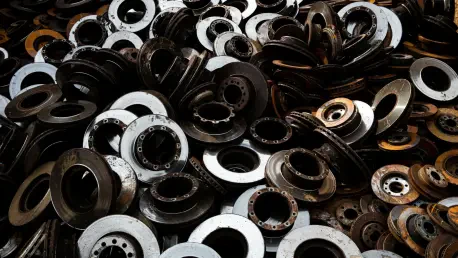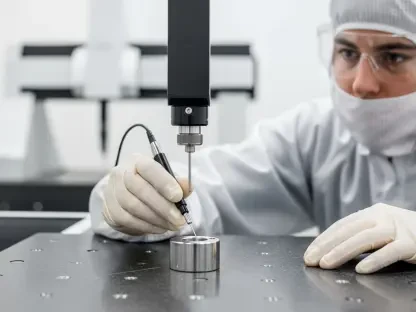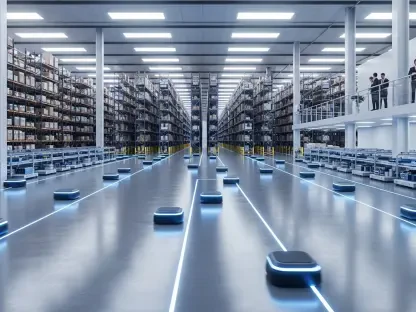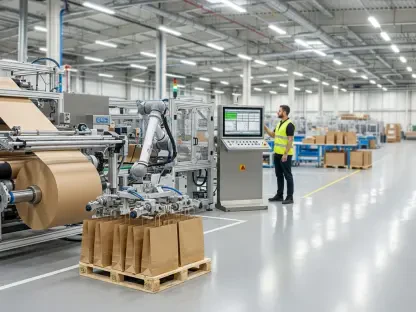The European scrap metal shredder market stands at a pivotal moment, with forecasts predicting a substantial leap from a valuation of $0.9 billion in the current year to an impressive $1.3 billion by 2035, driven by a compound annual growth rate (CAGR) of 3.7%. This growth trajectory underscores the critical role of shredders in metal recycling and steel production, industries that are increasingly central to Europe’s sustainability ambitions. These machines, designed to break down scrap into manageable sizes, facilitate efficient material reuse, aligning with the region’s push toward a circular economy. With an absolute increase of $380 million over the decade, representing a 42.9% rise, the market’s economic significance is undeniable. Beyond the numbers, this expansion reflects a broader narrative of industrial evolution, technological advancement, and environmental responsibility. The consistent demand for shredding equipment is fueled by stringent policies on waste reduction and resource recovery, alongside innovations that enhance operational efficiency. Regional disparities add further complexity, as some countries surge ahead with robust industrial bases and policy support. This article aims to unpack the intricacies of this dynamic sector, exploring growth drivers, market segmentation, challenges, and future trends, while offering stakeholders valuable insights into navigating the evolving landscape.
Market Overview and Growth Dynamics
Growth Projections and Phases
The projected climb of the European scrap metal shredder market to $1.3 billion by 2035 highlights a robust and sustained demand across the region, starting from a base value of $0.9 billion as of now. The market is set to experience a steady ascent over the next ten years. This growth is divided into two distinct phases, with the first spanning from the current year to 2030, during which an increase of $176.4 million is anticipated, bringing the market to $1.061 billion. This initial phase accounts for 46.4% of the total forecasted expansion, reflecting a strong start driven by immediate industrial needs and policy incentives. The consistency of this upward trend points to a market well-aligned with both economic and environmental priorities, setting a solid foundation for further development.
In the subsequent phase, from 2030 to 2035, the market is expected to add another $203.6 million, representing 53.6% of the overall growth over the decade, suggesting an acceleration fueled by maturing technologies and deeper integration of shredders into industrial processes. This slightly larger increment in the latter half indicates a promising trend for the industry. The steady CAGR of 3.7% through both phases offers a reliable indicator for stakeholders looking to invest or expand within this space. Such phased growth not only showcases the market’s resilience but also highlights its adaptability to evolving demands in metal recycling and steel production, ensuring long-term relevance in Europe’s industrial ecosystem.
Key Drivers of Expansion
Europe’s unwavering commitment to a circular economy stands as a primary catalyst for the scrap metal shredder market’s expansion, emphasizing metal recycling and waste minimization as cornerstones of sustainable industrial practice. Stringent environmental regulations across the region compel industries to adopt advanced shredding technologies to meet compliance standards, thereby boosting demand for efficient equipment. This regulatory push creates a ripple effect, encouraging companies to invest in solutions that reduce environmental impact while maintaining operational viability. The alignment of market growth with such overarching goals underscores the strategic importance of shredders in achieving broader sustainability targets.
Beyond policy, the surge in steel production and the pressing need for streamlined material processing further propel market demand, making shredders indispensable for breaking down scrap into reusable forms. As industries seek to optimize resources, these machines directly support cost efficiency and production goals. Additionally, technological advancements play a significant role, with automation and smart systems enhancing the appeal of modern shredders by improving performance and reducing downtime. These combined factors—policy mandates, industrial requirements, and innovation—create a fertile environment for market growth, positioning shredders as vital tools in Europe’s industrial and environmental landscape.
Market Segmentation Insights
Product Type Breakdown
Among the diverse offerings in the European scrap metal shredder market, hammer mill shredders dominate with a substantial 46.3% share as of the current year, a position attributed to their exceptional versatility and efficiency. These machines are particularly adept at processing a wide array of metals, from heavy ferrous materials to lighter alloys, making them a preferred choice across various recycling applications. Their ability to deliver consistent output sizes ensures that downstream processes, such as steel production, benefit from high-quality raw materials. This widespread applicability underpins their market leadership and reflects a broader trend of favoring equipment that can handle diverse operational demands.
In contrast, shear and flail shredders occupy smaller but significant niches within the market, catering to specialized needs that hammer mills may not fully address. Shear shredders, with their precise cutting mechanisms, are ideal for applications requiring clean, uniform cuts, often in processing specific metal types for high-value recovery. Flail shredders, on the other hand, excel in handling lighter, less dense materials, offering flexibility for smaller-scale operations. Together, these alternative product types complement the dominant hammer mills, ensuring that the market offers tailored solutions for a spectrum of recycling challenges, thereby enhancing overall industry adaptability.
Capacity Segments
When it comes to capacity, shredders in the 10-50 tons per hour (TPH) range hold a commanding 42.6% market share, striking an optimal balance between throughput and cost-effectiveness. This segment appeals strongly to medium-scale operations, such as regional recycling facilities, which require equipment capable of handling significant volumes without the hefty investment associated with larger systems. The popularity of this capacity range reflects a pragmatic approach among European operators, prioritizing scalability and efficiency in an environment where operational budgets often constrain equipment choices. This balance ensures that a wide range of businesses can participate in the recycling economy without overextending resources.
Meanwhile, shredders with capacities below 10 TPH and above 50 TPH address more specific needs within the market, serving distinct operational scales. Lower-capacity systems are often favored by small-scale dealers or localized operations where scrap volumes are limited, allowing for cost-efficient processing without excess capability. High-capacity systems, exceeding 50 TPH, cater to large industrial plants and major steel mills that process vast amounts of material daily, requiring robust equipment to maintain production flow. These varied capacity segments illustrate the market’s ability to cater to diverse industrial contexts, ensuring that both small and large players find suitable shredding solutions to meet their unique demands.
Material Type Focus
Ferrous metals dominate the material type segment of the European scrap metal shredder market, accounting for an overwhelming 62.4% of demand due to their critical role in steel and iron recycling. These materials, prevalent in industries like automotive and construction, require specialized shredding to remove contaminants and achieve the purity needed for high-quality steel production. The heavy reliance on ferrous metal processing underscores the market’s alignment with core industrial sectors, where recycling efficiency directly impacts production costs and output quality. Shredders designed for these materials often incorporate features like magnetic separation to enhance processing precision.
On the other hand, non-ferrous metals, such as aluminum and copper, are carving out a growing niche within the market, driven by their increasing importance in electronics and renewable energy applications. Although they constitute a smaller share, the unique challenges posed by their lower density and higher value necessitate tailored shredding solutions that prevent material loss and ensure optimal recovery. This segment’s growth reflects broader industrial trends toward diversification in material use, pushing manufacturers to innovate and adapt equipment designs. The distinct requirements of ferrous and non-ferrous metals highlight the market’s complexity, requiring a nuanced approach to equipment development and application.
End-User Applications
Scrap metal dealers emerge as the leading end-users in the European market, holding a significant 43.8% share due to their reliance on shredders to process a wide variety of incoming materials. Often dealing with scrap from diverse sources, such as demolished structures or end-of-life vehicles, these dealers require robust and flexible equipment to manage inconsistent material streams. Shredders enable them to transform unwieldy scrap into uniform, marketable forms, enhancing efficiency and profitability in a competitive sector. This dominant position underscores the critical role shredders play in the initial stages of the recycling value chain, where raw scrap is first prepared for further processing.
Steel mills and metal recycling plants also represent substantial end-user groups, integrating shredders directly into their production and recovery processes to meet specific operational needs. Steel mills prioritize high-throughput systems that ensure a steady supply of processed material for continuous production lines, focusing on purity and volume to maintain output quality. Metal recycling plants, meanwhile, emphasize versatility and environmental compliance, using shredders to handle large volumes while adhering to strict waste management standards. The distinct demands of these end-users shape equipment functionality, driving manufacturers to offer customized solutions that address varied industrial priorities across the recycling spectrum.
Regional Variations and Growth Patterns
Leading Markets in Europe
Poland stands out as the fastest-growing market for scrap metal shredders in Europe, boasting a remarkable CAGR of 4.6% over the forecast period, driven by rapid industrial expansion and supportive government initiatives. The country’s burgeoning metal processing sector benefits from relatively lower operational costs compared to Western counterparts, attracting significant investment in recycling infrastructure. This growth is further fueled by regional development programs that prioritize sustainability, positioning Poland as a key player in the European recycling landscape. The high growth rate from a developing base indicates a market with substantial untapped potential, drawing attention from equipment manufacturers seeking new opportunities.
Germany follows closely with a CAGR of 4.1%, leveraging its well-established recycling infrastructure and technological leadership to maintain a strong market position. As a hub for automotive and industrial scrap processing, the country benefits from a mature network of facilities that integrate advanced shredding technologies to optimize material recovery. Policy frameworks that encourage innovation and environmental stewardship further bolster growth, ensuring that German industries remain at the forefront of recycling efficiency. This combination of industrial strength and strategic focus makes Germany a benchmark for market maturity, influencing trends across the region with its high standards.
France, with a CAGR of 3.9%, demonstrates robust growth driven by a national emphasis on green policies and the integration of shredding technologies into industrial processes. The country’s commitment to reducing carbon footprints aligns with the adoption of efficient recycling equipment, particularly in metalworking sectors that generate significant scrap volumes. Investments in sustainable technologies, supported by government incentives, create a conducive environment for market expansion. France’s progress reflects a broader European trend of aligning industrial practices with environmental goals, positioning it as a leader in balancing growth with ecological responsibility.
Other Key Regions
The Netherlands, achieving a CAGR of 3.8%, excels in the adoption of innovative shredding technologies, particularly those incorporating IoT for real-time operational monitoring. Dutch industries, known for their forward-thinking approach, integrate smart systems to enhance efficiency and reduce downtime, aligning with national priorities on digital transformation in manufacturing. This focus on cutting-edge solutions not only drives market growth but also sets a precedent for technology adoption across Europe. The Netherlands’ role as an innovation hub underscores the potential for technology to reshape traditional industrial processes within the recycling sector.
Italy, Spain, and the UK also contribute significantly to regional growth, with CAGRs of 3.5%, 3.3%, and 3.2%, respectively, reflecting diverse industrial focuses and policy environments. Italy’s growth is supported by a strong manufacturing base that generates substantial scrap, necessitating efficient shredding solutions. Spain benefits from expanding industrial applications and recycling initiatives, while the UK adapts to a mature market landscape with a focus on post-regulatory adjustments. These variations highlight the differing levels of market maturity and industrial emphasis across Europe, illustrating a complex regional dynamic where local conditions shape growth trajectories and equipment demand.
Challenges and Market Restraints
Competitive and Operational Hurdles
One of the prominent challenges facing the European scrap metal shredder market is the competition posed by alternative processing methods, such as manual sorting or other size reduction technologies, which can undermine shredder adoption in certain segments. These alternatives, often perceived as less capital-intensive, appeal to smaller operators or regions with limited budgets, creating a barrier to market penetration for shredder manufacturers. Additionally, the inherent complexity of shredder equipment design and maintenance requirements can deter potential buyers, particularly those lacking the technical expertise or resources to manage sophisticated systems. Addressing these competitive pressures requires a focus on demonstrating the long-term value and efficiency gains of shredders over other methods.
Beyond competition, operational challenges further complicate market growth, as the diverse needs across different metal types and recycling applications hinder the standardization of shredding solutions. Equipment must often be customized to handle specific materials or volumes, increasing production costs for manufacturers and potentially raising prices for end-users. This lack of uniformity can slow adoption rates, especially among smaller-scale operators who prioritize affordability over tailored functionality. Overcoming these hurdles requires innovation in modular designs that offer flexibility without sacrificing cost-effectiveness, ensuring that shredders remain accessible to a broader range of industrial players across Europe.
Regulatory and Cost Barriers
Environmental compliance presents a dual-edged challenge for the European scrap metal shredder market, as the stringent regulations driving demand also impose significant financial burdens, particularly on smaller industry participants. Meeting waste reduction and resource recovery mandates often requires substantial investments in advanced equipment and operational adjustments, which can strain budgets for companies with limited capital. These compliance costs, while aligned with Europe’s sustainability objectives, create an uneven playing field where larger firms with greater resources can more easily adapt, potentially marginalizing smaller players. This financial pressure underscores the need for supportive mechanisms, such as subsidies or phased compliance timelines, to level access to market opportunities.
Simultaneously, manufacturers face the persistent challenge of balancing innovation with affordability to maintain competitiveness in a cost-sensitive market. Developing cutting-edge shredders with features like automation and energy efficiency involves high research and development expenditures, which can translate into higher product prices. Striking a balance between incorporating advanced technologies and keeping costs manageable remains a critical concern, as affordability directly influences adoption rates across diverse end-user segments. Solutions may lie in strategic partnerships or scalable product offerings that allow buyers to incrementally upgrade capabilities, thereby mitigating upfront financial barriers while still advancing market innovation.
Technological Innovations and Trends
Smart Shredding Solutions
The integration of smart shredding systems marks a transformative trend in the European scrap metal shredder market, with technologies like the Internet of Things (IoT) and artificial intelligence (AI) significantly enhancing operational efficiency. IoT-enabled sensors provide real-time data on equipment performance, detecting wear and tear before major issues arise, which allows for predictive maintenance that minimizes costly downtime. This capability is particularly valuable in high-volume recycling operations where uninterrupted processing is critical to maintaining profitability. The adoption of such intelligent systems reflects a broader shift toward digitalization in industrial equipment, positioning European markets at the forefront of technological integration.
AI further amplifies the impact of smart shredding by optimizing operational parameters such as speed and torque based on the specific material being processed, ensuring maximum efficiency and output quality. This adaptability reduces energy consumption and wear on equipment, extending its lifespan and lowering long-term costs for operators. As these technologies become more accessible, their adoption is expected to grow, driven by the region’s emphasis on precision and sustainability in recycling processes. The convergence of IoT and AI in shredding solutions not only improves day-to-day operations but also sets a new standard for equipment performance, influencing future innovations across the sector.
Advanced Processing Capabilities
High-capacity shredding systems equipped with variable speed drives represent another significant innovation, offering enhanced control over energy use and material throughput in European recycling operations. These drives allow operators to dynamically adjust power consumption based on load requirements, a critical feature given the region’s high energy costs and environmental focus. Such systems are particularly suited to large-scale facilities, like steel mills, where processing vast quantities of scrap demands both efficiency and cost management. The ability to fine-tune performance ensures that energy is not wasted, aligning with broader sustainability goals while maintaining high productivity levels.
Complementing this, advancements in cutting-edge designs using wear-resistant alloys and optimized shredding chambers extend equipment durability under harsh operating conditions. These innovations tackle the challenge of frequent maintenance, a common concern in heavy-duty recycling environments where abrasive materials can quickly degrade machinery. By enhancing lifespan and reducing repair frequency, such designs lower overall operational costs, making shredders a more attractive investment for industrial users. This focus on durability and efficiency highlights the market’s evolution toward solutions that deliver long-term value, reinforcing the role of technology in overcoming traditional operational constraints.
Sustainability Focus
Eco-friendly practices in shredder design are gaining traction across Europe, aligning seamlessly with the region’s circular economy objectives and regulatory frameworks aimed at reducing industrial environmental impact. Manufacturers are increasingly prioritizing energy-efficient motors and recyclable components in their equipment, minimizing the carbon footprint of both production and operation. This shift responds to growing demand from end-users who seek to meet stringent environmental standards without compromising on performance. The emphasis on sustainability not only enhances the marketability of shredders but also positions the industry as a key contributor to Europe’s green transition, fostering trust among stakeholders.
Moreover, the adoption of sustainable processing techniques, such as systems designed to minimize dust and noise pollution during operation, reflects a holistic approach to environmental responsibility. These features are particularly relevant in densely populated or regulated areas where industrial activities face strict oversight. By integrating such eco-conscious innovations, shredder manufacturers address both market demands and societal expectations, ensuring that their products contribute positively to community and environmental well-being. This trend toward sustainability is set to shape future equipment development, reinforcing the market’s alignment with Europe’s long-term ecological priorities and driving further innovation in green technologies.
Future Pathways and Industry Implications
Strategic Opportunities for Stakeholders
Reflecting on the robust growth of the European scrap metal shredder market, which expanded steadily with a projected rise to $1.3 billion by 2035, stakeholders have had ample opportunities to capitalize on emerging trends. Manufacturers have adapted by investing heavily in research and development to refine smart technologies and sustainable designs, ensuring their offerings meet the evolving demands of a circular economy. Collaborations with technology providers have proven instrumental, enabling the integration of IoT and AI solutions that enhance equipment efficiency. These strategic moves not only strengthen market positions but also address the pressing need for innovation in a competitive landscape, setting a precedent for future industry advancements.
End-users, including scrap metal dealers and steel mills, played a pivotal role by prioritizing equipment that balanced cost with environmental compliance, often opting for modular systems that allowed gradual upgrades. Policymakers supported this trajectory through targeted incentives and harmonized regulations, which alleviated financial burdens on smaller operators and fostered broader adoption of advanced shredders. These collective efforts underscored the importance of synergy across the value chain, where each participant contributed to sustaining market momentum. Moving forward, maintaining this collaborative spirit will be crucial to unlocking further growth and ensuring the industry’s resilience against operational and regulatory challenges.
Navigating Challenges with Innovation
Looking back, the challenges of equipment complexity and compliance costs had been significant hurdles, yet they spurred remarkable innovation within the European scrap metal shredder market. Manufacturers tackled these issues by developing user-friendly interfaces and scalable solutions, making advanced shredders more accessible to smaller operators who previously struggled with technical demands. Partnerships with training providers also emerged as a key strategy, equipping end-users with the skills needed to operate and maintain sophisticated systems effectively. These initiatives helped democratize access to cutting-edge technology, ensuring that market growth benefited a wider range of participants.
For future consideration, addressing cost barriers through financial mechanisms like subsidies or leasing models could further ease adoption, particularly in less mature markets. Continuous dialogue between industry players and regulators will be essential to refine compliance frameworks, ensuring they drive progress without stifling smaller firms. Investing in public awareness campaigns about the benefits of metal recycling and advanced shredding technologies may also cultivate greater demand, reinforcing the market’s economic and environmental value. By focusing on these actionable steps, the industry can build on past achievements, navigating lingering challenges with a proactive, innovation-driven approach that promises sustained success.









